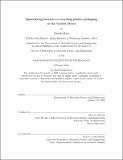Quantifying barriers to recycling plastic packaging in the United States
Author(s)
Ravi, Basuhi
DownloadThesis PDF (7.722Mb)
Advisor
Olivetti, Elsa A.
Terms of use
Metadata
Show full item recordAbstract
Staggering statistics about plastic waste and attendant concerns have driven multi-stakeholder engagement from entrepreneurs searching for innovative technological solutions and companies pledging circular measures to nations setting ambitious recycling targets. Yet, recycling rates for plastics remain abysmally low (<8\%). In this dissertation, I use a supply-demand approach to investigate why we don’t recycle more plastics and quantify barriers to better recovery and recycling outcomes. Recovery system architectures depend on geographic context. I examine plastic waste recovery in the United States (US), the world's largest producer of both total and per capita plastic waste. Of the 38 Mt of post-consumer plastic waste generated in the US in 2021, approximately 42% can attributed to single-use plastic packaging. I probe two large-volume plastic packaging contexts: PET (polyethylene terephthalate) bottles and flexible packaging made of PE (polyethylene) and PP (polypropylene). Demand for recycled PET has risen sharply due to policy and consumer pressures that target circularity. However, in the US, PET bottle collection rates have not increased in a decade, and the supply of recycled PET is unable to meet rising demand. Therefore, in the PET bottle case study, I quantify the cost of supply-side policy push to increase recovery. I find that deposit return systems invite incentivized consumers into the recycled PET value chain, and recycled content mandates for PET bottles can reduce the net cost burden of a nationwide deposit return system, improve PET bottle recycling rates to >80\% (from 24\%), and save 7.6 MtCO2eq per year. Unlike PET bottles, demand for mechanically recycled PE from flexible plastic packaging waste is low, but researchers are exploring advanced recycling pathways to divert hard-to-recycle packaging formats from disposal. I survey advanced recycling methods proposed in the literature and investigate the techno-economic potential for their market scalability. I find that large-volume products such as fuels or feedstock chemicals are limited by the availability of plastic waste at low costs. On the other hand, high-value end-uses such as fine chemicals are constrained by process yields and unmatched scale of plastic waste generation. I generalize these findings to examine the role of policy in improving the plastics recycling landscape in the US. Lastly, I discuss the petrochemicals value chain and the significance of displacement in realizing the expected environmental benefits of plastics recycling.
Date issued
2024-02Department
Massachusetts Institute of Technology. Department of Materials Science and EngineeringPublisher
Massachusetts Institute of Technology